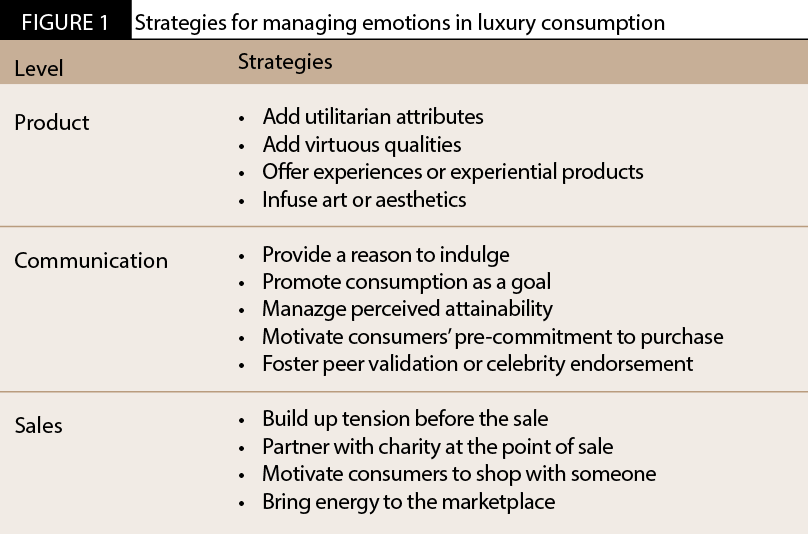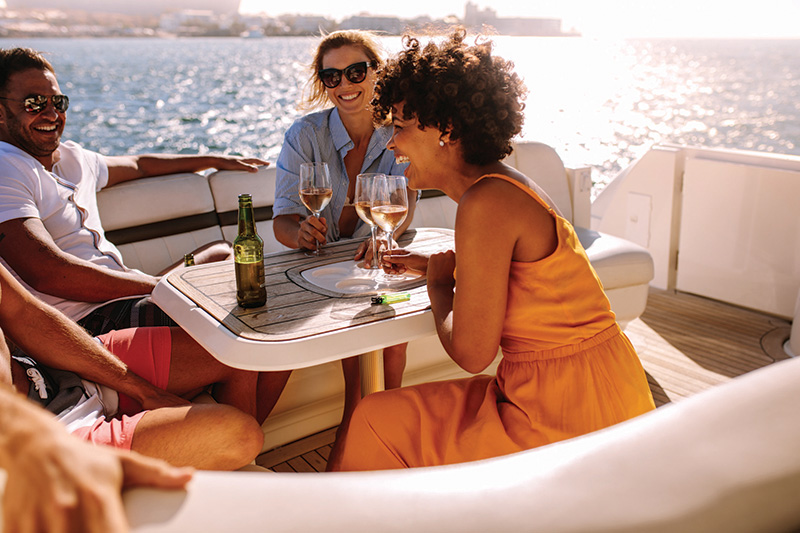By Francine Espinoza Petersen and Mariana Soberano
Buying luxury impacts not only consumers’ wallet, but also their hearts. In this article, we provide a deeper understanding of the emotions that consumers feel when buying luxury and other indulgences. To create an overall more positive luxury experience, we revert to scientific research to provide managers with the tools to improve consumers’ emotional mix, maximizing the positive feelings and minimizing the negative ones.
Consumers feel mixed emotions from consuming luxury
Consuming luxury has been historically marketed as a path to happiness and mighty living. Some brands suggest their products can make consumers feel good (Canali: “I choose my Canali because it makes me feel good wherever I am in the world”) or like they have never felt before (Rolex: “a territory your emotions have never known before”). A look into the literature suggests that these are not empty claims and that luxury consumers indeed experience positive feelings. At the same time, most research seems to agree that luxury consumption evokes not only emotions of positive, but also of negative valence, a paradox tellingly described by the term “guilty pleasure”1. Luxury consumers can feel happy and pleased, but also guilty and regretful after their purchases2-4.
Hedonic indulgences, such as luxury, have been found to enhance positive emotions of happiness4, pride5, or excitement, driven by contexts of rare occurrence, new milestones, when consuming feels special, or when they represent something the consumer had previously struggled to attain6. In addition, under certain circumstances, indulging in luxury can contribute to mood improvement7 and personal well-being8.
There is also a considerable portion of research focusing on the “dark side of luxury”9, 10.
Because luxury consumption is considered to be beyond basic needs, studies found that luxury consumers can experience guilt, shame, or regret, rooted in the sense of no self-control, irresponsible or wasteful consumption, and lack of merit or justification for indulging10-14. When luxury is regarded as an undue privilege, feelings of inauthenticity may also haunt the consumer and drive their confidence down15. Moreover, when considering the general high prices of luxury products, consumers might also feel the “pain of paying”14, 16. Finally, luxury can also have a social cost: if it is seen by others as an effort to impress and gloat, instead of making luxury consumers more appealing as friends, they can actually be less preferred and be perceived as less warm9, 17.
Brands can drive positive emotions by implementing strategies at several levels
The uncalibrated mix of emotions luxury consumers might feel raises challenges for brands and calls into questioning whether and how can they live up their credo and make consumers feel good, overall. Based on a systematic investigation of scientific research, we derive specific strategies that luxury brands can use to enhance the positive and reduce the negative emotions from buying luxury. To facilitate its application, we structured these strategies into a three-tier framework anchored in a company’s product, communication, and sales (Figure 1).

2.1 Product
To some extent, brands can engineer consumers’ feelings. One way researchers have found to enhance the experience of luxury consumption is to add utilitarian attributes to luxury products18. These “functional alibis” provide consumers with a justification for a seemingly unnecessary purchase and mitigate their sense of guilt. For instance, consider the example of Mercedes Benz’s description of one of its cars: “ML350 SUV offers stylish proof that utility and safety can coexist enthusiastically with performance and luxury”.
Adding virtuous qualities to luxury purchases can provide consumers with a “license to indulge” and also alleviate feelings of guilt. Research suggests that luxury marketers can do this by giving consumers the option to donate to charity or volunteer for a cause19, 20. Committing to these virtuous acts before deciding to consume luxury can even increase consumers’ preference for indulging as a well-deserved treat after their noble actions. An interesting example of the application of this strategy can be found by looking at the chocolate brand Tony’s Chocolonely21. The brand is known for fighting to eradicate slavery from the chocolate industry, and not only promotes this message in their marketing campaigns and website, but also made sure to include a reference to this goal in the design of all their products, reminding the consumer of their cause. Instead of the classic chocolate squares, their chocolate tablets are divided in irregular shapes to depict the inequalities of wealth distribution between producers and farmers in the chocolate industry.
Studies suggest that both experiences and experiential products can provide superior well-being than material goods22, 23. With these findings in mind, luxury marketers can create a new dimension to their offerings by associating their products with experiences. One brand who has been successfully using this strategy to improve consumers’ experience and involvement with the brand, while “trading up” their products to a high premium level, is Nespresso. With the creation of a “Nespresso Club” and carefully decorated stores with top of the class customer service, the brand has managed to elevate coffee consumption to a whole new experiential level.
Sometimes the concepts of luxury, fashion and art seem to overlap. As illustrated by Carolina Herrera, the founder of the luxury clothing brand with the same name: “the difference between fashion and art is that fashion is art in movement”24. Indeed, some luxury goods are considered to be highly aesthetic, “artsy”, and often associated with fine taste and beauty25. Following this virtuous perception of luxury, some researchers claim that while utilitarian products are supposed to satisfy consumers, luxury is meant to delight them26. Promoting this ideal, brand managers can infuse art in their products to create a heightened sense of aesthetic and enhance consumers’ experience and the appraisal of their products27. Some applications of this strategy could be the use of artwork in packaging, advertisement, or in the actual design of their products28.
2.2 Communication
Brands have been proactively telling consumers why they should indulge, further validating their longings (for example, L’Oréal long-running campaign “because you’re worth it”). Indeed, it has been demonstrated that having a reason to consume can reduce consumers’ guilt and increase consumption happiness for most consumers4. This strategy might also yield positive downstream consequences, such as increased satisfaction with the purchase.
In addition, framing luxuries as goals, aligned with positive long-term outcomes, seems to increase their attractiveness and reduce aversion to luxury consumption29. Given the strong association between high-quality, durability, and some luxury items, one example of this strategy could be to frame consumption as a good long-term investment30. Brands can also connect the luxury purchase to goals of greater life satisfaction, financial well-being, or well-deserved rewards.

Advertisement for luxury brands is known for grand displays of success, confidence, and social superiority. Researchers investigating the effectiveness of this approach on brand perception found that consumers’ envy plays a role31. “Benign envy” increases desire and positive brand attitude, while “malicious envy” may color the brand as arrogant and snob (“show-off”) and have a negative impact on brand attitude. To resolve this conflict, marketers can advertise a brand as “attainable”, not too dominant or aggressive, but as a reachable aspirational ideal. This can be done, for example, by advertising non-threatening scenarios to which the consumer can relate, featuring a smiling couple or children playing. This could be enough to generate feelings of “benign envy” and produce a positive impact on consumers’ emotions and brand perception.
Earlier we mentioned that luxury consumers might experience guilt following their purchases. In a study on the dynamics of guilt from consumption, researchers found that these negative feelings can arrive even before consumption31. The authors differentiated decision guilt, which comes from knowing “one will commit a guilt-inducing act” (e.g., booking an all-inclusive stay in the Bahamas), from action guilt, which is felt when carrying out the act of consumption (e.g., actually boarding the plane). Increasing the temporal gap between these two moments not only helps to ease the guilt felt while consuming, but also increases indulgent consumption while decreasing post-behavior atonement. These findings can have interesting use to advertisers. Brands can create distance between decision and action by encouraging consumers to decide and pre-commit in advance, for example by sending mailings suggesting consumers to pre-order14, 32.
Peer validation or celebrity endorsement are other ways managers can promote a positive perception of the brand and generate excitement about potential purchases6. Examples of these strategies would be the use of consumer ratings, word-of-mouth, and hiring celebrities to advertise the brand or as brand ambassadors (for example Johnny Depp on Dior’s perfume Savage, or George Clooney as Nespresso’s spokesman).
2.3 Sales
Teaming luxury products with charitable contributions at the point of sale is another effective strategy that gives consumers the feeling of justified or earned “right to indulge” in luxury, while soothing the guilt associated with the purchase33. One example of partnering luxury with charity at the point of sale is the collaboration between Gucci and UNICEF34. At Gucci stores, customers can find specific products that contribute to this non-profit organization and learn more about this collaboration.

Brands can raise consumers’ excitement about their future purchases by building up tension until the sale6. There are several ways brands can achieve this, either by giving the perception that their products are scarce (e.g. limited stock), temporary (e.g. limited/special edition), or hard to obtain (e.g. waiting lists). The anticipation and tension generated by these tactics will foster excitement in the consumer, which is in turn heightened by the feeling of competition with the remaining consumers with the same shopping goals.
Consumers also report feeling excited about their purchases when sharing the consumption experience with others6. Interestingly, an experiment with female participants showed that even with no interaction with others, just by being with someone, the attention paid to luxury products was greater than when being alone35.
At the marketplace, immersive excitement can be amplified by stimulating the senses and using energetic elements such as light, sound, heat, and speed/tempo6. Such elements can function as emotional triggers for surprise, trust, and joy in the consumers36. Through the manipulation of customers’ senses (sight, sound, smell, taste, touch), brands can differentiate themselves, motivate consumers to engage with the brand, plus add an aesthetic and exciting feel to their products37. An interesting example is Louis Vuitton’s newly renovated store in west London. After being closed for more than one year for renovations, the store reopened with colorful bright fixtures and a whole new concept. In an interview, the architect responsible for the project, who has been working with the brand since 1994, adds: “there has been a real revolution towards something lighter, clearer and dare I say, happier”38.
Conclusion
When it comes to luxury, offering exceptional products with an exquisite design might not be enough to contribute to consumers’ happiness. As luxury brands are conceptually different from others, brand managers should take special care in designing fitting luxury experiences that make consumers go from buying a “product” to buying into a “way of life”39. Considering the mix of emotions that luxury consumers experience, it is important for brands to take an active role in making sure their offerings have a positive impact on consumers’ lives. The range and depth of the emotions previously mentioned depends, naturally, on a multitude of factors. But attentive brands are expected to know their customers the best, making it in their power to improve how they feel. Several strategies have been here presented to this effect, so it’s up to brands to deliberate which ones to choose and adapt them to their own reality.
This article is originally published on September 30, 2021.
About the Authors

Francine Espinoza Petersen is Associate Professor of Marketing at HEC Lausanne, University of Lausanne and an academic partner of HEC Lausanne’s Swiss Center for Luxury Research (SCLR). Her research focuses on consumer emotions and well-being. Her work aims at improving consumption experiences and deliver value via consumer experience and consumer happiness.

Mariana Soberano is a PhD student and Graduate Assistant in the Department of Marketing of HEC Lausanne, University of Lausanne. She holds a MSc in Innovation and Technological Entrepreneurship, a BSc in Economics, and has experience as a marketing and pricing analyst. Her research interests include consumers’ behavior and well-being.
References:
- Goldsmith, K., E.K. Cho, and R. Dhar, When Guilt Begets Pleasure: The Positive Effect of a Negative Emotion. Journal of marketing research, 2012. 49(6): p. 872-881.
- Ramanathan, S. and P. Williams, Immediate and Delayed Emotional Consequences of Indulgence: The Moderating Influence of Personality Type on Mixed Emotions. The Journal of consumer research, 2007. 34(2): p. 212-223.
- Mukhopadhyay, A. and G.V. Johar, Tempted or Not? The Effect of Recent Purchase History on Responses to Affective Advertising. Journal of Consumer Research, 2007. 33(4): p. 445-453.
- Petersen, F.E., H.J. Dretsch, and Y. Komarova Loureiro, Who needs a reason to indulge? Happiness following reason-based indulgent consumption. International journal of research in marketing, 2018. 35(1): p. 170-184.
- McFerran, B., K. Aquino, and J.L. Tracy, Evidence for two facets of pride in consumption: Findings from luxury brands. Journal of consumer psychology, 2014. 24(4): p. 455-471.
- Pham, M.T. and J.J. Sun, On the Experience and Engineering of Consumer Pride, Consumer Excitement, and Consumer Relaxation in the Marketplace. Journal of retailing, 2020. 96(1): p. 101-127.
- Atalay, A.S. and M.G. Meloy, Retail therapy: A strategic effort to improve mood. Psychology & marketing, 2011. 28(6): p. 638-659.
- Hudders, L. and M. Pandelaere, The Silver Lining of Materialism: The Impact of Luxury Consumption on Subjective Well-Being. Journal of happiness studies, 2012. 13(3): p. 411-437.
- Cannon, C. and D.D. Rucker, The Dark Side of Luxury: Social Costs of Luxury Consumption. Personality & social psychology bulletin, 2019. 45(5): p. 767-779.
- De Barnier, V. and E. Roux, The Dark Side of Luxury: When Negative Emotions Are Felt by Very Wealthy Consumers, in Understanding Luxury Fashion: From Emotions to Brand Building, I. Cantista and T. Sádaba, Editors. 2020, Springer International Publishing: Cham. p. 63-87.
- Giner-Sorolla, R., Guilty Pleasures and Grim Necessities: Affective Attitudes in Dilemmas of Self-Control. Journal of personality and social psychology, 2001. 80(2): p. 206-221.
- Lascu, D.-N., Consumer Guilt: Examining the Potential of a New Marketing Construct. Advances in consumer research, 1991. 18: p. 290.
- Kivetz, R. and Y. Zheng, Determinants of Justification and Self-Control. Journal of experimental psychology. General, 2006. 135(4): p. 572-587.
- Kivetz, R. and I. Simonson, Earning the Right to Indulge: Effort as a Determinant of Customer Preferences toward Frequency Program Rewards. Journal of marketing research, 2002. 39(2): p. 155-170.
- Goor, D., et al., The Impostor Syndrome from Luxury Consumption. The Journal of consumer research, 2020. 46(6): p. 1031-1051.
- Prelec, D. and G. Loewenstein, The Red and the Black: Mental Accounting of Savings and Debt. Marketing science (Providence, R.I.), 1998. 17(1): p. 4-28.
- Garcia, S.M., K. Weaver, and P. Chen, The Status Signals Paradox. Social psychological & personality science, 2019. 10(5): p. 690-696.
- Keinan, A., R. Kivetz, and O. Netzer, Functional Alibi. Advances in consumer research, 2009. 36: p. 27.
- Khan, U. and R. Dhar, Licensing Effect in Consumer Choice. Journal of marketing research, 2006. 43(2): p. 1.
- Strahilevitz, M. and John G. Myers, Donations to Charity as Purchase Incentives: How Well They Work May Depend on What You Are Trying to Sell. The Journal of consumer research, 1998. 24(4): p. 434-446.
- our mission – Tony’s Chocolonely. [cited 2021 15/07/2021]; Available from: https://tonyschocolonely.com/int/en/our-story/our-mission.
- Nicolao, L., J.R. Irwin, and J.K. Goodman, Happiness for Sale: Do Experiential Purchases Make Consumers Happier than Material Purchases? The Journal of consumer research, 2009. 36(2): p. 188-198.
- Guevarra, D.A. and R.T. Howell, To have in order to do: Exploring the effects of consuming experiential products on well-being. Journal of consumer psychology, 2015. 25(1): p. 28-41.
- Zellweger, R., Carolina Herrera Talks to Renee Zellweger on The Evolution of Elegance, in Harper’s BAZAAR. 2016, @harpersbazaarus.
- Hagtvedt, H., Research Handbook on Luxury Branding, in Art and aesthetics. 2020, Edward Elgar Publishing.
- Chitturi, R., R. Raghunathan, and V. Mahajan, Delight by Design: The Role of Hedonic versus Utilitarian Benefits. Journal of marketing, 2008. 72(3): p. 48-63.
- Hagtvedt, H. and V.M. Patrick, Art Infusion: The Influence of Visual Art on the Perception and Evaluation of Consumer Products. Journal of Marketing Research, 2008. 45(3): p. 379-389.
- Batat, W., Transforming Luxury Brand Experiences through Artification: A Marketing and Consumer Research Perspective. Marché et organisations, 2019. 35(2): p. 135-151.
- Haws, K.L. and C. Poynor, Seize the Day! Encouraging Indulgence for the Hyperopic Consumer. The Journal of consumer research, 2008. 35(4): p. 680-691.
- Sun, J. J., S. Bellezza, and N. Paharia, N. Buy Less, Buy Luxury: Understanding and Overcoming Product Durability Neglect for Sustainable Consumption. Journal of Marketing, 2021. 85(3), 28-43.
- Sung, B. and I. Phau, When pride meets envy: Is social superiority portrayal in luxury advertising perceived as prestige or arrogance? Psychology & marketing, 2019. 36(2): p. 113-119.
- Duke, K.E. and O.N. Amir, Guilt Dynamics: Consequences of Temporally Separating Decisions and Actions. The Journal of consumer research, 2019. 45(6): p. 1254-1273.
- Hagtvedt, H. and V.M. Patrick, Gilt and Guilt: Should Luxury and Charity Partner at the Point of Sale? Journal of retailing, 2016. 92(1): p. 56-64.
- Gucci and UNICEF USA’s Partnership to Save and Protect Children. [cited 2021 15/07/2021]; Available from: https://www.unicefusa.org/supporters/organizations/companies/our-corporate-partners/gucci.
- Pozharliev, R., et al., Merely Being with You Increases My Attention to Luxury Products: Using EEG to Understand Consumers’ Emotional Experience with Luxury Branded Products. Journal of marketing research, 2015. 52(4): p. 546-558.
- Thomke, S., The magic that makes customer experiences stick. MIT Sloan Management Review, 2019. 61(1): p. 56-63.
- Schmitt, B., Experiential Marketing. Journal of Marketing Management, 1999. 15(1-3): p. 53-67.
- Levy, N., Peter Marino channels happiness for renovation of Louis Vuitton store in west London, in Dezeen. 2019.
- Grigorian, V. and F.E. Petersen, Designing luxury experience. 2014, ESMT Working Paper.



































